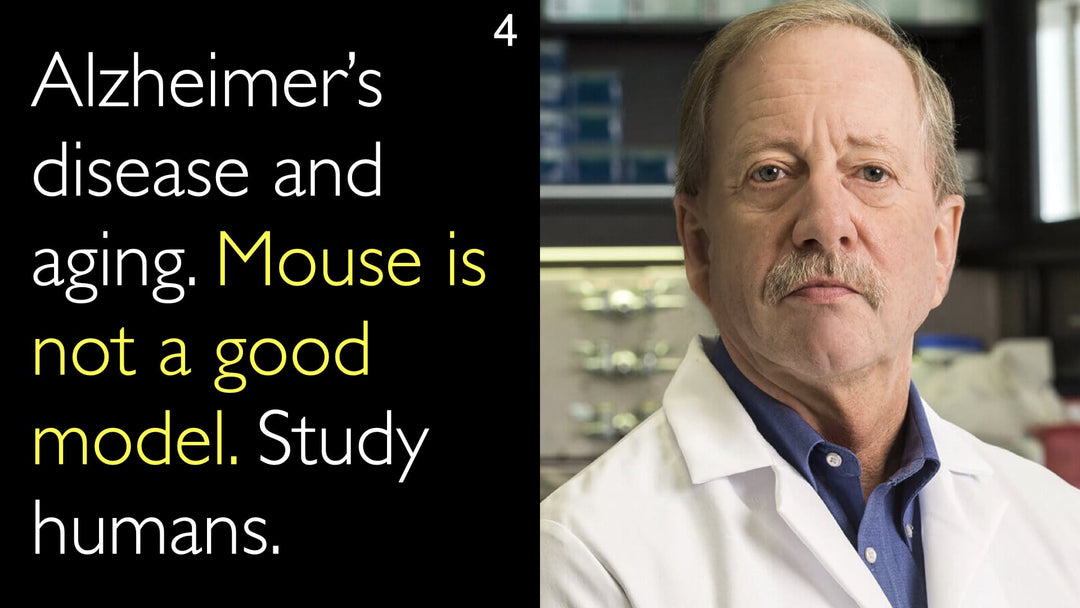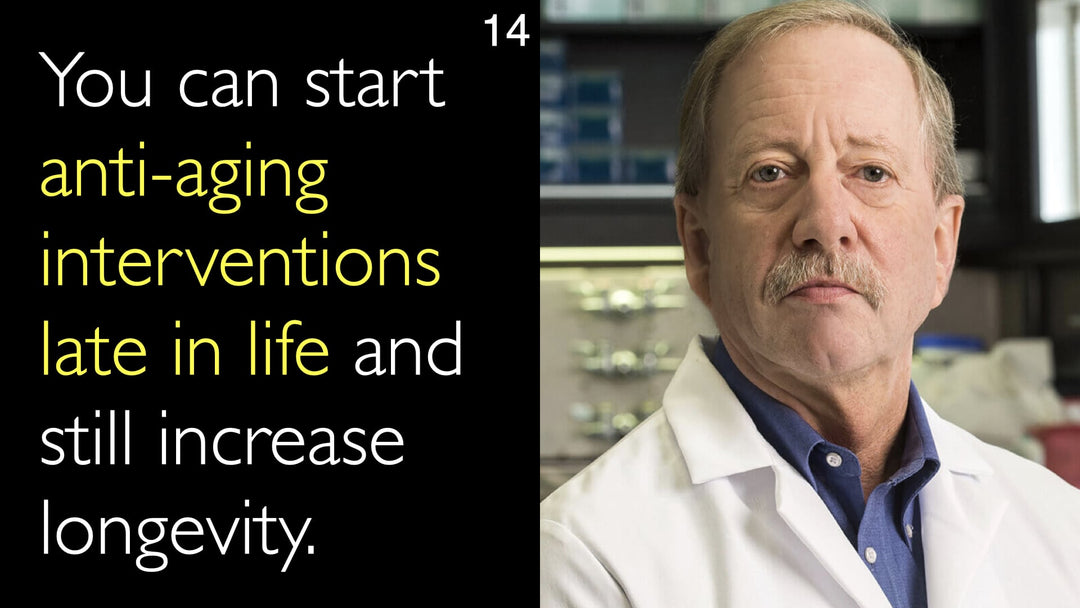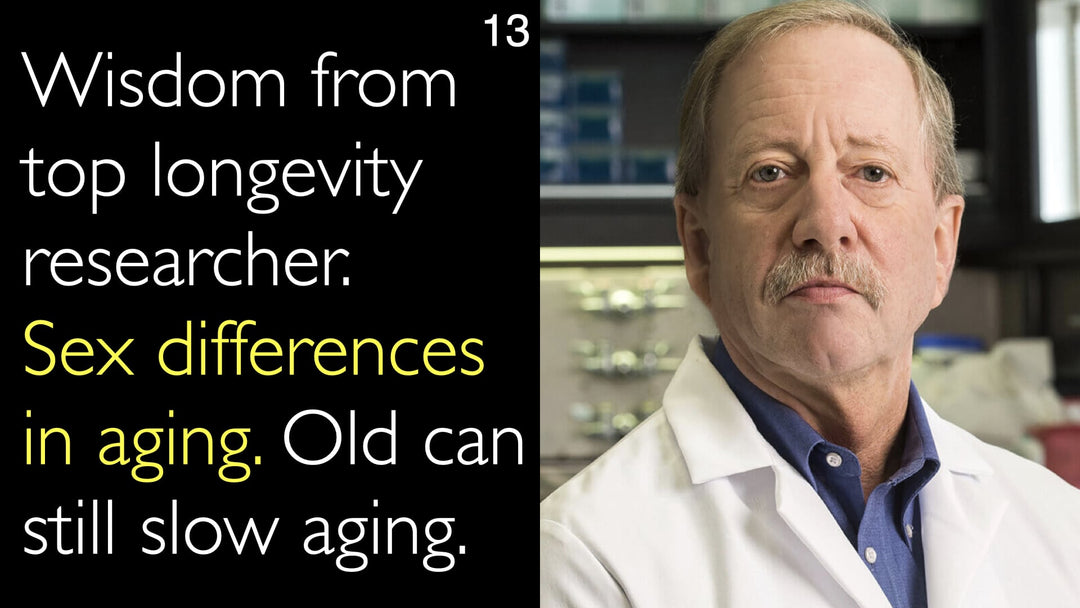Dr. Steven Austad, MD, PhD, ein führender Experte für Altersbiologie, erläutert, warum die Alzheimer-Forschung bisher gescheitert ist. Er beleuchtet die Grenzen von Mausmodellen für die Erforschung des kognitiven Abbaus beim Menschen und diskutiert die Suche nach besseren natürlichen Modellen sowie die komplexen sozialen Determinanten der Erkrankung. Besonders betont er die schützende Wirkung von Bildung, Einkommen und körperlicher Aktivität gegen Demenz.
Grenzen von Tiermodellen in der Alzheimer-Forschung und -Prävention
Abschnitte
- Versagen von Mausmodellen in der Alzheimer-Forschung
- Die Suche nach natürlichen Alzheimer-Krankheitsmodellen
- Ist Alzheimer eine menschenspezifische Erkrankung?
- Soziale Determinanten des Demenzrisikos
- Schützende Faktoren gegen kognitiven Abbau
- Zukünftige Forschungsrichtungen für Alzheimer
- Vollständiges Transkript
Versagen von Mausmodellen in der Alzheimer-Forschung
Laut Dr. Steven Austad, MD, PhD, stellt die Alzheimer-Forschung ein spektakuläres Versagen dar. Er verweist darauf, dass über 300 Therapien, die in Mausmodellen entwickelt wurden, sich nicht in wirksame Behandlungen für Menschen übertragen ließen. Diese ernüchternde Bilanz führt Dr. Austad zu einer entscheidenden Schlussfolgerung: Die Maus ist als Modell ungeeignet, um die komplexe Biologie der menschlichen Alzheimer-Erkrankung zu verstehen.
Die Suche nach natürlichen Alzheimer-Krankheitsmodellen
Ein zentrales Problem in diesem Bereich ist das Fehlen geeigneter Tiermodelle. Dr. Steven Austad, MD, PhD, erläutert, dass aktuelle Modelle lediglich genetische Karikaturen darstellen. Forscher übertragen menschliche Gene, die Alzheimer auslösen, in Mäuse – ein stark vereinfachter Ansatz. Selbst Schimpansen, die genetisch zu über 99 % mit Menschen identisch sind, entwickeln in der Regel keine Alzheimer-Erkrankung, was sie für natürliche Modellstudien unbrauchbar macht.
Ist Alzheimer eine menschenspezifische Erkrankung?
Dr. Steven Austad, MD, PhD, diskutiert faszinierende alternative Modelle wie den Grauen Mausmaki. Dieser winzige Primat weist bei postmortalen Untersuchungen Gehirnläsionen auf, die Alzheimer-ähnlich erscheinen. Allerdings, so Dr. Austad, liegen diese Läsionen in anderen Hirnregionen als beim Menschen. Diese Beobachtung legt nahe, dass Alzheimer eine einzigartig menschliche Erkrankung sein könnte – was die Forschung erheblich erschwert.
Soziale Determinanten des Demenzrisikos
Humanstudien sind aufgrund unkontrollierbarer Variablen schwierig. Dr. Steven Austad, MD, PhD, betont, dass sich Menschen weder zu einheitlicher Ernährung noch zu identischen Lebensstilen zwingen lassen. Die Alzheimer-Krankheit wird tiefgreifend von sozialen Faktoren beeinflusst. Dr. Austad verweist auf rätselhafte Korrelationen, die Wissenschaftler zu entschlüsseln versuchen – etwa die schützende Wirkung von höherer Bildung und höherem Einkommen gegen Demenz.
Schützende Faktoren gegen kognitiven Abbau
Die Forschung beginnt, modifizierbare Risikofaktoren für Alzheimer zu identifizieren. Dr. Steven Austad, MD, PhD, nennt körperliche Aktivität als zentralen Schutzfaktor. Diese Erkenntnis, kombiniert mit dem Einfluss von Bildung und sozioökonomischem Status, ergibt ein komplexes Bild. Laut Dr. Austad zeigt dies, warum einfache Mausmodelle der Gesamtheit der menschlichen Alzheimer-Erkrankung nicht gerecht werden können.
Zukünftige Forschungsrichtungen für Alzheimer
Das Interview mit Dr. Steven Austad, MD, PhD, unterstreicht einen Paradigmenwechsel in den Neurowissenschaften. Das wiederholte Scheitern von Mausmodellen erfordert neue Ansätze. Dr. Austads Einsichten plädieren für einen stärkeren Fokus auf menschenspezifische Forschung und die Einbeziehung sozialwissenschaftlicher Erkenntnisse. Das Verständnis der biologischen Mechanismen hinter Faktoren wie Bildung und Bewegung ist entscheidend für künftige Durchbrüche in Prävention und Behandlung.
Vollständiges Transkript
Dr. Anton Titov, MD: Alzheimer und andere Demenzerkrankungen korrelieren mit dem Altern. Was sind innovative Ansätze zum Thema kognitives Altern?
Dr. Steven Austad, MD: Die Alzheimer-Krankheit ist für einen vergleichenden Biologen wie mich äußerst faszinierend. Unser Versagen, wirksame Maßnahmen gegen Alzheimer zu entwickeln, ist spektakulär. Trotz über 300 Therapien, die in Mausmodellen getestet wurden, gibt es noch immer keine Behandlungen.
Das führt mich zu der Überzeugung, dass die Maus nicht ausreicht, um die menschliche Biologie zu verstehen. Ein Problem ist das Fehlen guter Tiermodelle. Bislang haben wir lediglich menschliche Alzheimer-Gene in Mäuse eingebracht – was nur eine Karikatur der Krankheit erzeugt.
Es scheint keine natürlichen Modelle zu geben. Man könnte meinen, Schimpansen, die zu über 99 % genetisch mit uns identisch sind, würden Alzheimer entwickeln. Doch das ist nicht der Fall – zumindest nicht häufig genug, um es studieren zu können.
Wir brauchen also bessere natürliche Modelle. Einige sind faszinierend und könnten hilfreich sein, etwa der winzige Primat Grauer Mausmaki, der nur 100 Gramm wiegt. Post mortem zeigen sich in seinen Gehirnen Läsionen, die Alzheimer ähneln – allerdings an anderen Stellen als beim Menschen. Das könnte bedeuten, dass Alzheimer eine menschenspezifische Erkrankung ist. Ganz sicher sind wir uns noch nicht.
Das erschwert die Forschung erheblich, denn Menschen sind schlechte Versuchsmodelle. Wir können sie nicht zu einheitlicher Ernährung oder Lebensweise zwingen. Zugleich wird Alzheimer von vielen sozialen Faktoren beeinflusst.
Es gibt eine biologische Ebene, die wir noch nicht verstehen: Warum senkt höhere Bildung das Alzheimer-Risiko? Warum sind Menschen mit höherem Einkommen besser geschützt?
Langsam zeichnen sich Erkenntnisse ab – etwa dass körperliche Aktivität vor Alzheimer schützt. All dies zusammen zeigt, wie begrenzt Mausmodelle sind, um eine so komplexe menschliche Erkrankung wie Alzheimer zu erfassen.







